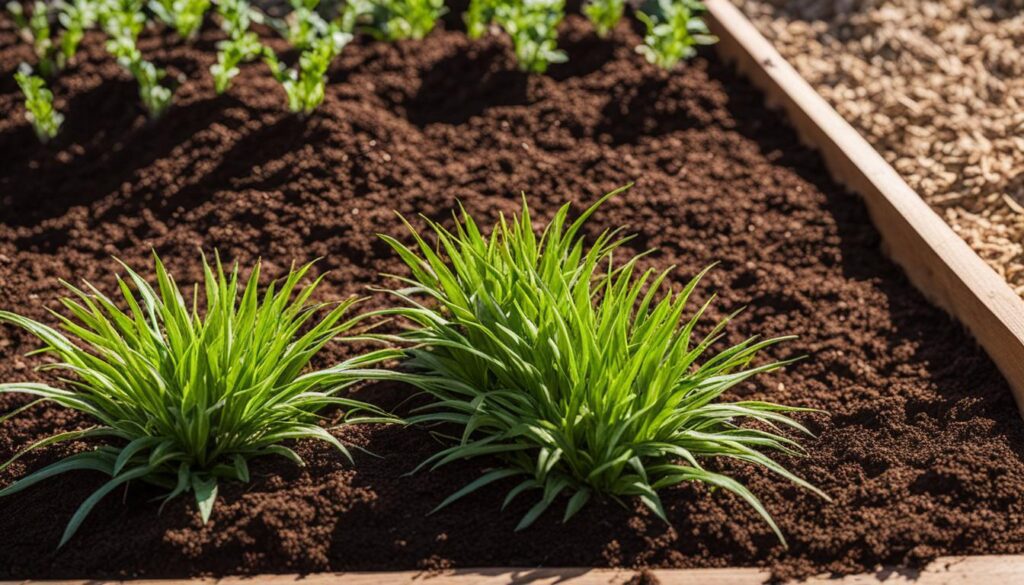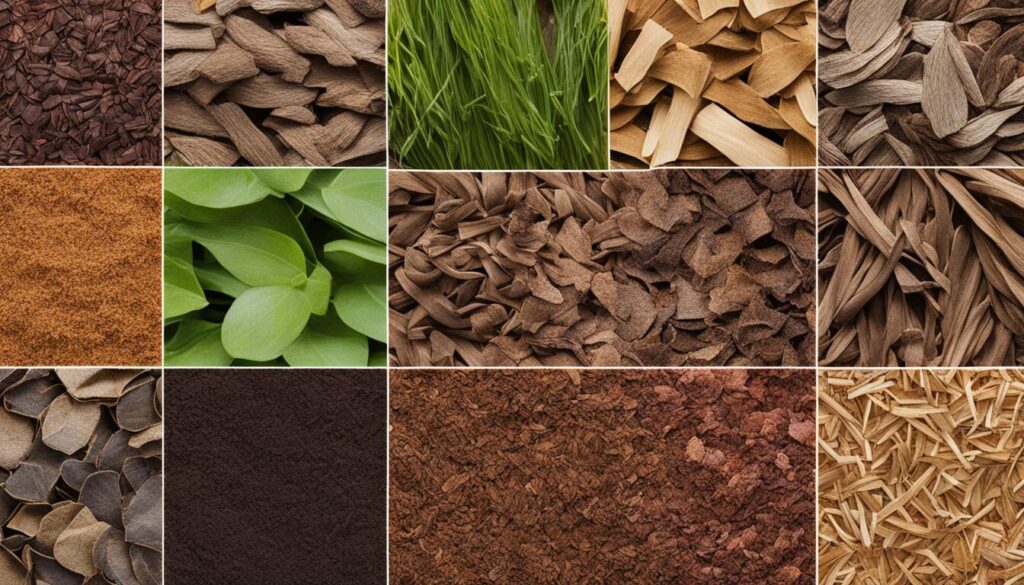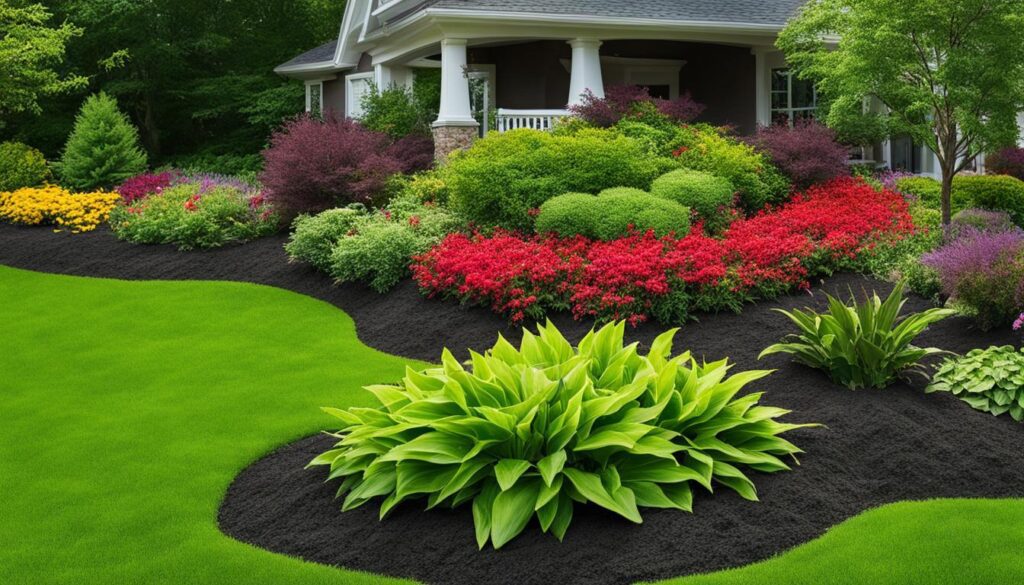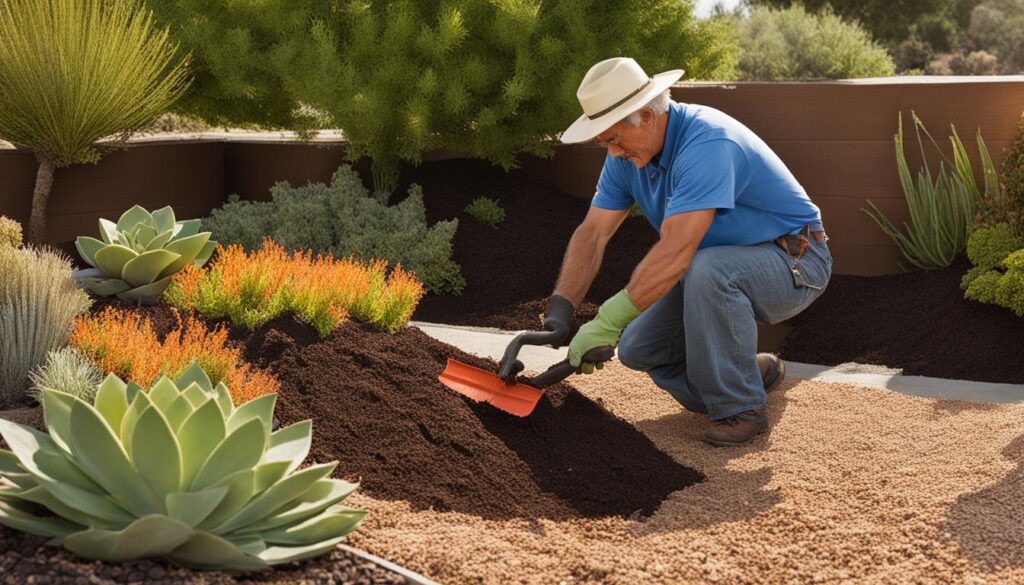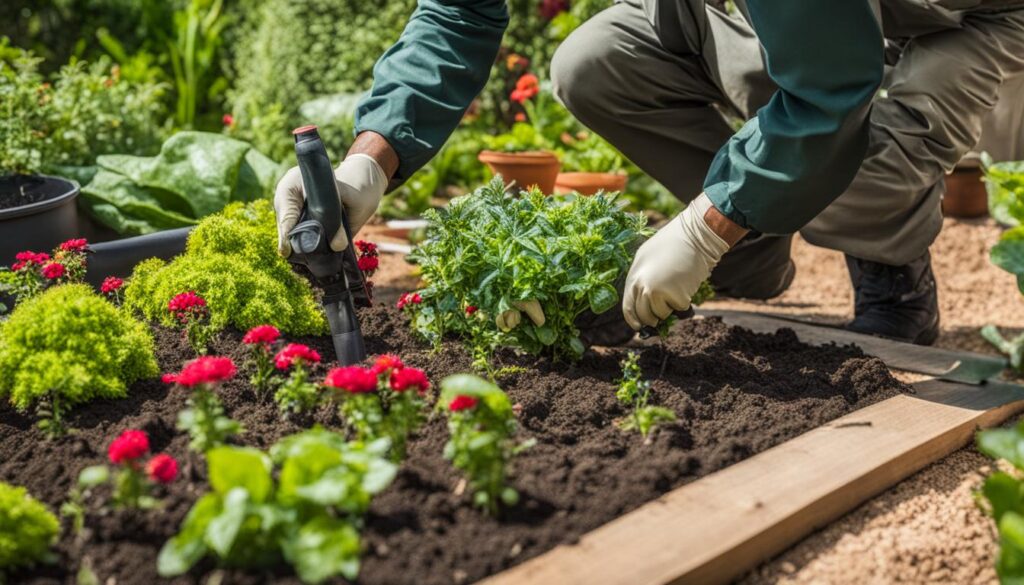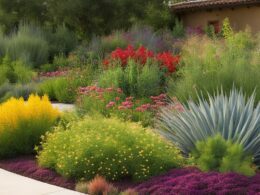Welcome to our guide on mulching techniques for creating and maintaining healthy xeriscape gardens. In this article, we will explore the magic of mulch and how it can benefit your garden. Whether you’re an experienced gardener or just starting out, understanding the importance of mulch and how to use it effectively will help you create a thriving and sustainable landscape.
As you embark on your journey to create a beautiful xeriscape garden, mulching will be your secret weapon. Not only does mulching conserve water and enrich the soil, but it also helps in weed prevention and temperature regulation. By incorporating the right mulching techniques, you can transform your garden into a haven of beauty and sustainability.
Key Takeaways:
- Mulching is essential for maintaining healthy xeriscape gardens.
- Using the right mulching techniques helps conserve water and enrich the soil.
- Mulch plays a magical role in replenishing nutrients, conserving moisture, and preventing weed growth.
- There are various types of mulch, including organic and inorganic options, each with its own benefits.
- Proper application and maintenance of mulch are important for its effectiveness.
The Magic of Mulch
Mulch is like a magician in your garden, performing a variety of tricks to keep your plants happy and healthy. One of the greatest benefits of mulch is its ability to regenerate the soil. As it breaks down over time, mulch releases essential nutrients into the soil, providing a steady supply of food for your plants. This nutrient-rich soil encourages strong root growth and overall plant vitality.
Another magical power of mulch is its ability to conserve moisture. By creating a barrier between the soil and the air, mulch helps to reduce evaporation, keeping the soil moist for longer periods. This is especially important in xeriscape gardens, where water conservation is key. By retaining moisture in the soil, mulch helps to reduce the frequency of watering and promotes a more sustainable garden.
“Mulching is like giving your plants a cozy blanket to snuggle up in. It helps them stay warm in cold weather and cool in hot weather.”
When it comes to weed prevention, mulch truly works its magic. By forming a protective layer over the soil, mulch blocks sunlight from reaching weed seeds, preventing them from sprouting. This natural weed barrier reduces the need for herbicides and manual weeding, saving you time and effort in maintaining a weed-free garden.
Soil Regeneration
Mulch helps to regenerate the soil by releasing nutrients and creating a favorable environment for beneficial microorganisms. This improves the overall health and fertility of the soil, providing a solid foundation for your plants to thrive.
Moisture Conservation
By acting as a barrier, mulch helps to reduce evaporation and retain moisture in the soil. This is particularly important in xeriscape gardens, where water conservation is a priority.
Weed Prevention
Mulch forms a protective layer over the soil, blocking sunlight from reaching weed seeds and preventing their germination. This reduces the need for manual weeding and the use of herbicides, making for a more sustainable garden.
Types of Mulch
When it comes to mulching your garden, you have several options to choose from. There are three main types of mulch: organic, inorganic, and synthetic. Each type has its own unique benefits and considerations, so it’s important to choose the right one for your specific needs.
Organic Mulch
Organic mulch is made from natural materials such as shredded hardwood, bark, compost, manure, and straw. It is a popular choice among gardeners because it enriches the soil as it decomposes, adding valuable nutrients and improving overall soil health. Organic mulch also helps retain moisture in the soil, reduces weed growth, and regulates soil temperature. It is an eco-friendly option that promotes a healthy and sustainable garden ecosystem.
Inorganic Mulch
Inorganic mulch, on the other hand, is made from materials that do not decompose. Examples include plastic, sheet mulches, wood chippings, and pebbles. Inorganic mulch is often chosen for its durability and long-lasting nature. It is effective at suppressing weeds, conserving moisture, and providing a clean and manicured look to your garden. However, it does not contribute to soil fertility like organic mulch does.
Synthetic Mulch
Synthetic mulch is made from artificial materials such as rubber or plastic. It is a low-maintenance option that can last for many years. Synthetic mulch is effective at controlling weed growth and conserving moisture, but it does not contribute to soil health. It is often used in commercial landscaping or in areas where a long-lasting and uniform appearance is desired.
When choosing the type of mulch for your garden, consider factors such as your gardening goals, the specific plants you are growing, and the overall aesthetic you want to achieve. Organic mulch is a popular choice for its soil-enhancing benefits, while inorganic and synthetic mulches offer long-lasting weed suppression and moisture retention. Experiment with different types to find the one that works best for your garden.
Benefits of Mulching
Mulching is a fantastic technique that offers a plethora of benefits for your garden. Whether you’re growing vegetables, flowers, or shrubs, incorporating mulch into your gardening routine can make a remarkable difference in the health and productivity of your plants.
Suppresses Weed Growth
One of the key advantages of mulching is its ability to suppress weed growth. The layer of mulch acts as a natural barrier, blocking sunlight from reaching weed seeds and preventing them from germinating and sprouting. This not only saves you time and effort spent on weeding but also reduces competition for nutrients and water, allowing your plants to thrive.
Retains Moisture in the Soil
Another significant benefit of mulching is its ability to retain moisture in the soil. The layer of mulch acts as a protective barrier, reducing evaporation and preventing water loss. This is particularly crucial in xeriscape gardens or areas with limited water availability. By conserving moisture, mulch helps to ensure that your plants have a constant water supply, even during dry spells.
Regulates Soil Temperature
Mulch also plays a vital role in regulating soil temperature. It acts as an insulating layer, keeping the soil cooler in hot summer months and warmer during cold winter periods. This temperature regulation creates a more stable environment for your plants’ roots, which in turn promotes healthy growth and minimizes stress. Additionally, mulch provides protection against extreme temperature fluctuations, helping your plants withstand harsh weather conditions.
Enhances Soil Fertility
Lastly, mulching enhances soil fertility by enriching the soil with organic matter. As the mulch breaks down over time, it releases essential nutrients into the soil, providing a continuous source of nourishment for your plants. This improves soil structure, promotes beneficial microbial activity, and encourages earthworms and other soil organisms to thrive. The result is healthy, nutrient-rich soil that supports robust plant growth.
By incorporating mulching into your gardening routine, you can enjoy these benefits and create a thriving, beautiful garden. Whether you’re looking to suppress weeds, retain moisture, regulate soil temperature, or enhance soil fertility, mulch is an invaluable tool for maintaining a healthy and productive garden.
How to Apply Mulch
Applying mulch correctly is essential for maximizing its benefits in your garden. By following these steps, you can ensure that your mulch layer is prepared, applied, and maintained properly:
Preparing the Garden
- Start by removing any existing weeds, grass, or debris from the area where you plan to apply mulch. This will help prevent weed growth and ensure that the mulch has direct contact with the soil.
- Loosen the soil using a garden fork or tiller. This will improve water and nutrient absorption, allowing the plants to thrive.
- If your soil is lacking in organic matter or nutrients, consider adding compost or well-rotted manure to enrich it. This will provide additional nourishment for your plants.
Applying the Mulch
Once your garden is prepared, it’s time to apply the mulch. Follow these steps for an even and effective mulch layer:
- Spread the mulch evenly over the soil, avoiding piling it up against the stems or trunks of plants. A layer that is two to three inches thick is usually sufficient, as anything thicker can prevent water and air from reaching the soil.
- Take care not to cover plant crowns, as this can lead to rot and other issues. Leave a small gap around the base of each plant to allow for airflow and prevent moisture buildup.
Maintaining the Mulch Layer
Regular maintenance is important to keep your mulch layer in good condition. Follow these tips for maintaining the mulch:
- Periodically check the mulch layer and remove any weeds that may have sprouted. This will help maintain a clean and weed-free garden.
- Loosen the mulch gently with a rake to prevent it from becoming compacted. This will allow for better water penetration and airflow.
- Monitor the moisture level of the soil beneath the mulch and water as needed. Mulch helps retain moisture, but it’s important to ensure that the plants receive adequate hydration.
By following these guidelines, you can effectively apply mulch to your garden and reap the benefits it provides. Your plants will thank you for it!
How Can Mulching Help with Xeriscape Landscaping for Beginners?
Mulching is essential in beginner xeriscape landscaping ideas as it helps retain moisture, suppresses weeds, and regulates soil temperature. Mulch also enhances the aesthetic appeal of the landscape by providing a uniform and neat appearance. Additionally, it enriches the soil as it breaks down over time, contributing to the overall health of the xeriscape garden.
Potential Issues and Solutions
When it comes to mulching, there are a few potential issues that you should be aware of in order to maintain the health of your plants. One common issue is the presence of pests such as slugs and snails. These creatures can wreak havoc on your garden, feasting on your plants and causing significant damage. However, there are certain types of mulch that can act as a deterrent to these pests. For example, cedar mulch has natural properties that repel slugs and snails, keeping them away from your precious plants.
Another concern with mulching is the possibility of diseases affecting your plants. Excessive moisture can create the perfect environment for diseases such as root rot to thrive. To prevent this, it’s important to ensure that your mulch layer is not too thick and that water is able to drain properly. Additionally, using organic mulch that has been properly composted can help promote a healthy balance of microorganisms in the soil, which can further reduce the risk of diseases.
To maintain plant health, it’s also important to periodically inspect your mulch layer. Remove any moldy or decaying mulch, as this can attract pests and contribute to the spread of diseases. By keeping your mulch layer clean and healthy, you can create an environment that promotes the growth of strong and vibrant plants.
In summary, while mulching offers many benefits, it’s crucial to be mindful of potential issues that may arise. Protecting your plants from pests and diseases is essential for maintaining a thriving garden. By choosing the right type of mulch, properly maintaining it, and implementing pest and disease management strategies, you can ensure the long-term health of your plants and enjoy the full benefits of mulching.
Conclusion
Mulching is a powerful technique that can transform your xeriscape garden into a thriving and beautiful landscape. By understanding the magic of mulch, choosing the right mulching techniques, and applying them correctly, you can reap the benefits of water conservation, soil enrichment, and enhanced plant health.
By incorporating mulching into your gardening routine, you can conserve water by reducing evaporation and weed growth. Mulch acts as a natural barrier, preventing moisture loss and regulating soil temperature, creating a favorable environment for your plants to flourish.
Whether you opt for organic or inorganic mulch, it’s important to select the right type for your garden’s specific needs. Organic mulches, such as shredded hardwood or compost, can enrich the soil as they break down over time. Inorganic mulches, like plastic or pebbles, offer longer-lasting weed prevention and moisture retention capabilities.
So, why wait? Start implementing mulching techniques in your xeriscape garden today, and witness the transformative power of mulch as it conserves water, enriches the soil, and creates a healthy and sustainable environment for your plants to thrive.






